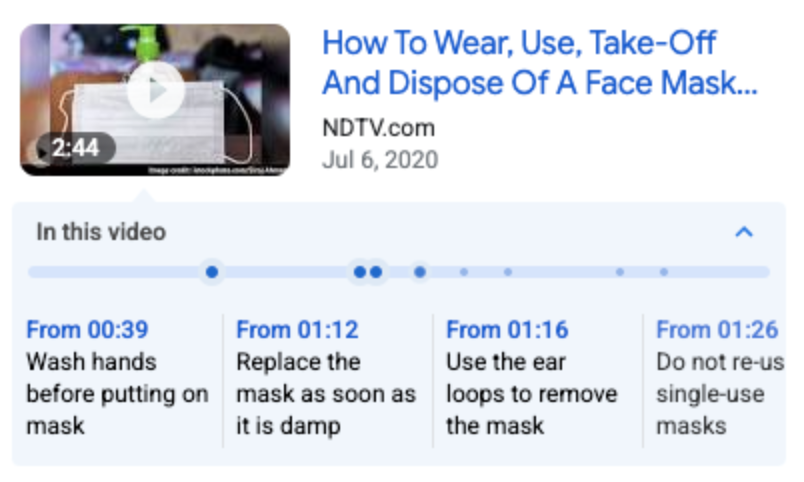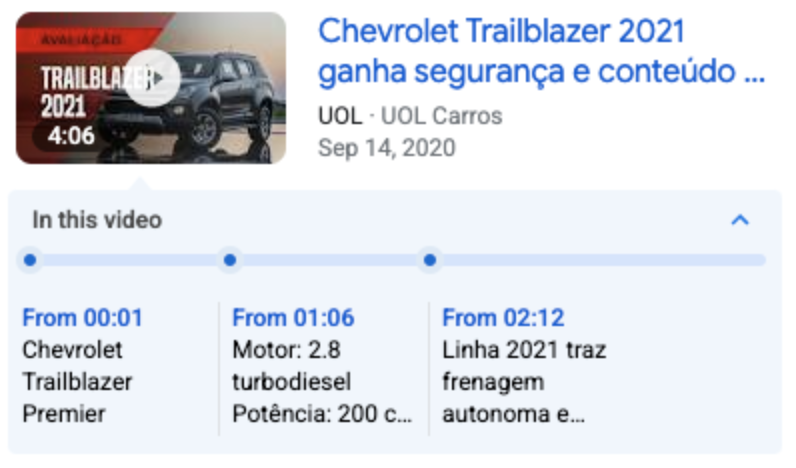Montag, 19. Juli 2021
Seit der Einführung der Funktion „Wichtige Momente“ für Videos im Jahr 2019 haben wir sie kontinuierlich erweitert und verbessert. Wir haben das Design weiterentwickelt und die Funktion in allen Regionen für mehr Videos verfügbar gemacht, in denen die Google Suche verfügbar ist, sowohl auf Mobilgeräten als auch Computern. Mit wichtigen Momenten können mehr Menschen direkt die relevantesten Segmente eines Videos sehen und es wie die einzelnen Kapitel in einem Buch durchgehen.
Heute führen wir eine neue Möglichkeit ein, mit der ihr wichtige Momente für Videos auf eurer Website aktivieren könnt, ohne jedes Segment manuell mit einem Label versehen zu müssen. Dazu müsst ihr Google nur das URL-Muster mitteilen, mit dem man zu einem bestimmten Zeitstempel im Video springen kann. Google ermittelt dann mithilfe von KI wichtige Momente im Video und zeigt Links direkt zu diesen Momenten in den Suchergebnissen an.


Die Bekanntgabe des SeekToAction-Betatests erfolgte während der Google I/O. Heute beenden wir die Betaphase der Funktion und unterstützen dieses Markup zukünftig für jede Website mit Videos. Hier ein paar Tipps für die Implementierung dieses Markups:
- Es muss möglich sein, auf euren URLs Deeplinks zu einem anderen Punkt als dem Startpunkt im Video hinzuzufügen. Beispiel:
https://www.example.com/example?t=30startet nach 30 Sekunden Videolaufzeit. - Verwendet
SeekToAction-Markup auf allen Videoseiten, auf denen Google wichtige Momente automatisch erkennen soll, und folgt unseren zusätzlichen Richtlinien. Hier findet ihr ein ausführliches Beispiel. - Damit wichtige Momente in eurem Video automatisch erkannt werden können, muss Google die Inhaltsdateien eurer Videos abrufen können.
Beachtet, dass das SeekToAction-Markup nur auf Videos angewendet wird, die auf eurer eigenen Website eingebettet sind. Wenn ihr Videos auf Plattformen von Drittanbietern postet, auf denen ihr das schema.org-Markup nicht verwaltet, könnt ihr bei diesen Plattformen nachfragen, ob dieses Markup unterstützt wird.
Wir hoffen, dass das SeekToAction-Markup eine einfachere und effizientere Möglichkeit für euch ist, um wichtige Momente zu aktivieren und Nutzern eine eingehendere Interaktion mit euren Videos zu ermöglichen. Wenn ihr Fragen habt, könnt ihr diese im Forum posten, euch an @googlesearchc auf Twitter wenden oder uns direkt auf unseren Dokumentationsseiten Feedback geben.
